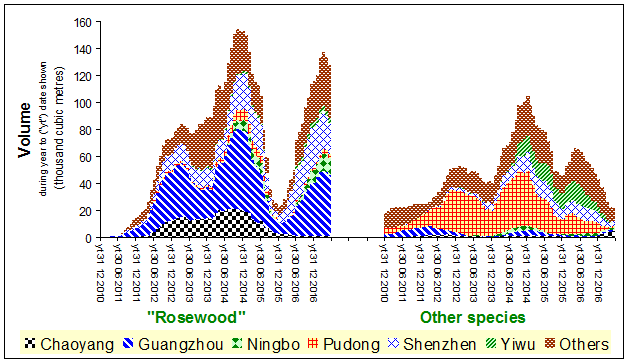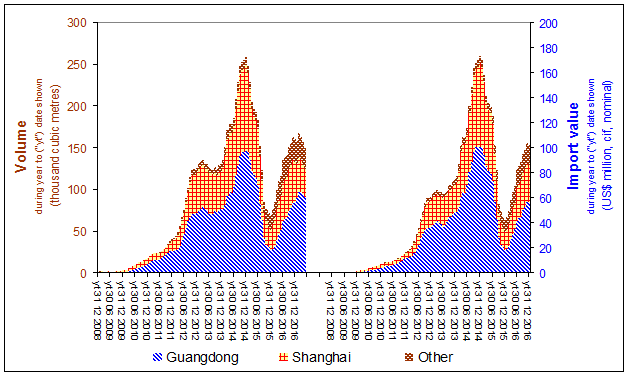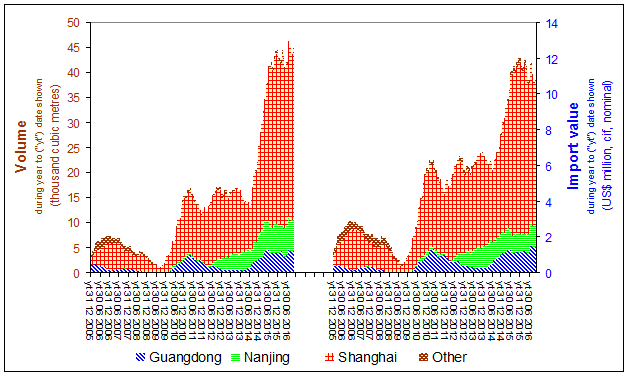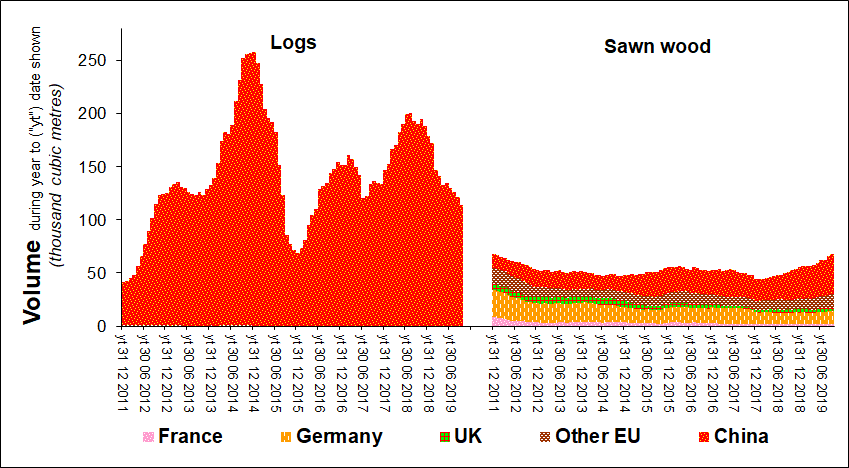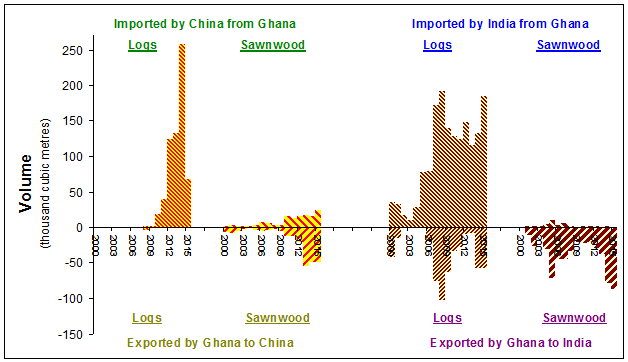|
|
||||||||||||||||||||||||||||||||||||||||||||||||||||||||||||||||||||||||||||||||||||||||||||||||||||||||||
|
|
||||||||||||||||||||||||||||||||||||||||||||||||||||||||||||||||||||||||||||||||||||||||||||||||||||||||||
|
Ghana |
||||||||||||||||||||||||||||||||||||||||||||||||||||||||||||||||||||||||||||||||||||||||||||||||||||||||||
|
Chart A1 - China's
imports from Ghana of "rosewood" & other logs
(by "location of importer")
Chart A2 - China's
imports from Ghana of logs
(by "customs district")
China's
imports of "rosewood" logs from Ghana (source:
as above)
Note: volumes shown since 01 01 2014 are estimates based on source data in units of weight.
Chart B - China's
imports of sawn wood from Ghana
(by "customs district") Chart C -
Imports
of timber from Ghana by China and the EU-28 Chart D - Ghana's
exports of tropical timber
|
||||||||||||||||||||||||||||||||||||||||||||||||||||||||||||||||||||||||||||||||||||||||||||||||||||||||||
|
Chart A1 illustrates the diffusion locations for China's imports of logs and sawnwood Ghana, although Guangzhou and Pudong account for most of the respective totals. Chart B indicates the large sums of money at stake and, by extension, that modest investment in improvements to the customs services of Ghana (including cross-checking with their counterparts in China) might generate substantial returns to Ghana's national treasury and reduce the incentives for illegal logging and related fraud and smuggling. During July 2012, the government of Ghana announced that a task force would assess the origins of the logs being transported within Ghana. The task force seems to have been disbanded without a formal assessment having been made. Nevertheless, the logging of rosewood from Ghana has been prohibited since January 2014[-][-][-]. Ghana prohibits the export of logs, unless these derive from tree plantations. Ghana is said to have a small area of rosewood / kpatro plantations. Since July 2014, the government of Ghana has not only revoked the licences of all seven of the companies authorised to export rosewood, but also revoked all permits to fell rosewood trees and banned the transit of rosewood through Ghana (this tending to be wood from Ghana smuggled out of Ghana and imported back into Ghana as if from elsewhere). If Ghana bothered to request that all countries respect those export (and logging) bans, the volume of logs being exported from Ghana would presumably reduce. Consistent with international law, China appears to ignore the self-evident illegality of the logs which it imports from Ghana. Although some of those logs might originate in countries other than Ghana, Ghana being recorded as the last country of embarkation prior to import by China, the origin of much of the total is probably forest in Ghana (particularly towards the north of the country, especially not far from where Chinese enterprises have been involved in so-called "development" projects - including the controversial Bui hydro-electric project). Indeed the timning of these projects is understood to correlate closely with the in illegal exploitation of rosewood in Ghana.and that exploitation calls into question Ghana's commitment to the VPA[-] Allegations of Chinese complicity in poachng for ivory,[-] including in conjunction with rosewood (in the vicinity of Mole National Park) and in crimes in the mining sector[-][-] - within Ghana have been made. It is alleged that China has retaliated to Ghana's expulsion of several thousand Chinese people who were in Ghana illegally - rather than seeking to curb illegal migration. Chains of supply for the logs which China imports from Ghana are likely to be similar to those for China's imports of logs (typically rosewood) from other countries in western Africa, Mozambique and Central America. They are also likely to involve foreign nationals. It is inconceivable that Chinese embassies are unaware of these supplies. In so far as these supplies harm the reputation of China and any aspirations it may have to become a global hegemon, it is remarkable that those embassies appear unwilling to intercede (implying complicity or pressure from those who have more power). Unlike other countries, China claims never (directly) to interfere in the affairs of other countries. However, Chinese enterprises and the Chinese diaspora are presumably not so constrained. Despite several years of assistance provided by the European Commission and EU Member States under the EU's FLEGT Action Plan "FLEGT" (primarily under a Voluntary Partnership Agreement "VPA" between Ghana and the EU), there appears to have been no support under FLEGT for law enforcement or customs controls in Ghana (or anywhere else). The VPA applies to all products to all destinations (including the market within Ghana). As Chart C above indicates, the volume of illegal logs which China records as imports from Ghana has, since late 2012, exceeded the roundwood equivalent volume of timber which the EU records as imports from Ghana. It is unclear why stakeholders have de facto excluded those logs from the scope of the VPA. A recent report suggests that the VPA and perhaps the EC's Regulation 995/2010 might help launder illegal timber deriving from forest logged under special Salvage Permits.[pp12-15, 18, 21, 22, 24] In so far as a handful of timber groups account for a large majority of Ghana's exports to the EU and given that these groups tend to have been members of WWF's Ghana Forest Trade network for many years, one might expect not only that their exports to the EU are legal but that the EU accounts for a very small minority of Ghana's illegal production of logs. However, because most logs produced in Ghana (especially for end-use within Ghana) are illegal and also because trees having qualities sought in the EU have become scarce, it mighty be tempting for at least some export-oriented mills to procure illegal wood in order to overcome temporary shortages. A significant proportion of the output of timber companies based in Ghana's Free Zones is likely to be destined for end-use within Ghana.[p3] Nigeria accounts for the surge and then decline in Ghana's exports of plywood shown on Chart D. China accounts for the rise in Ghana's exports of sawn wood during 2013. Chart B suggests that, during 2013, the volume of sawn wood imported by China amounted to about 16,000 cubic metres, approximately 40,000 cubic metres less than the volume which Ghana exported to China. This large discrepancy is unlikely to be attributable to timing differences. Given the very much larger discrepancy concerning logs, it may be that China classifies as logs what Ghana classifies as sawn wood, which tends to indicate fraud. Post-Independence governments (directly or indirectly) managed the nation's forest resources in ways that have led to severe degradation of those forests and the fragmentation of the timber industry. A major expansion in tree plantations owned and managed at small holder level, rather than at an industrial scale appear necessary if Ghana is not soon to be unable to meet its own domestic demand for timber. The output of its tree plantations, predominantly teak (and some gmelina), tends to be exported to India rather than being used to offset demand in Ghana for timber from natural forest. A boom in environmentally unsustainable economic growth stimulated by crude oil will presumably tend not only to increase timber production for end-use within Ghana but, by association, also to accelerate deforestation and climate change. The issue of carbon in forest (an anachronism given the urgency with which North America, Europe and East Asia must reduce their greenhouse gas footprints) has become a major distraction for those with an interest in forest governance in Ghana. The government has unilateraly decided to vest in itself the carbon in the trees for which the peoples' of Ghana have been long term stewards, making the marketability of trees fraught. Chart E above indicates the potential scale of customs (and other) fraud - in India - concerning the supply of teak (as logs and sawnwood) from Ghana. Successful efforts to combat this probable fraud would presumably help make the current expansion of teak and other wood plantations (including with support from the Africa Development Bank) more viable as a source of building and furnishing material in Ghana as a substitute for tropical timber. There is concern that that expansion in plantation area might not have FPIC -little if any land in Ghana is unencumbered with usufruct or other rights, which would be threatened by the land use change to plantations.
Further information:
|
||||||||||||||||||||||||||||||||||||||||||||||||||||||||||||||||||||||||||||||||||||||||||||||||||||||||||
|
Copyright
globaltimber.org.uk
|
||||||||||||||||||||||||||||||||||||||||||||||||||||||||||||||||||||||||||||||||||||||||||||||||||||||||||

